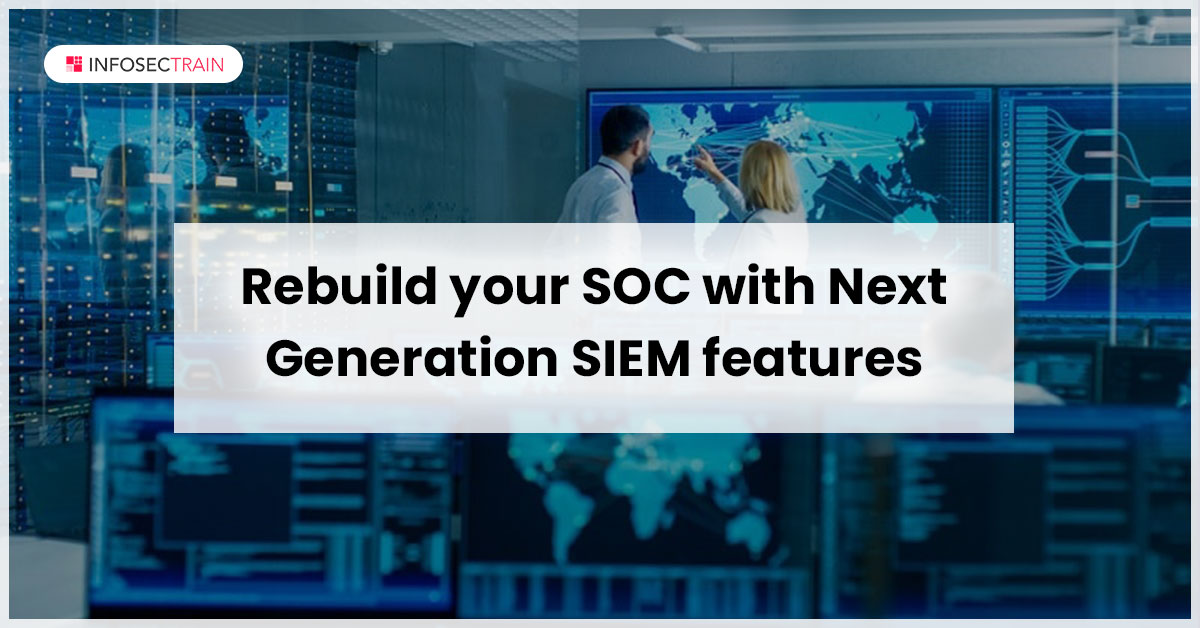Rebuild Your SOC with Next Generation SIEM Features
Security Information and Event Management (SIEM) is a great solution that helps identify threats and analyze security events to develop security incident response in real-time using ample amounts of data sources. The Next Generation SIEM uses Artificial Intelligence (AI) and Machine Learning (ML) methodologies to detect malicious events. This comprehensive blog is developed to provide the significant features of Next Generation SIEM that could enhance your organization’s security posture.

What is Next Generation SIEM?
The Next Generation SIEM will ingest both log and flow data and use threat models to identify the threats. These complicated threat models help to detect and match threat behaviors to find the type of threat, such as a DDoS attack, brute force attack, malware infection, APTs loss of credentials, or insider attack. It will leverage ML to identify the unusual behaviors of the device, application, or user.
Further, correlate these events with other rule triggers into a threat model. If a match is identified, the alert is triggered to aggregate individual threat behaviors under the Single Line Alert on the UI. The best Next-Gen SIEMs will be designed to identify the threats in less time becoming active. It helps mitigate brute force attacks, compromised credentials, and insider threats before accessing critical data.
Initial SIEM Challenges
- SIEM adds automation with human interaction that would take hours to respond to security alerts.
- The SIEMs generated many false positives, adding to the workload of the security teams.
- SIEM monitors behavior, but it cannot prevent insider threats.
- SIEM analyzes data and network behavior but can’t make context-aware decisions about what to do with the analysis.
- SIEM platforms are incapable of identifying possible threats.
- SIEMs struggled to handle the emerging threats as technology improved, and as a result, the cyber risk to enterprises increased.
- SIEM platforms are primarily static, while network data is fluid. It can analyze data stores and compare current network behavior to historical norms, but not enough to adjust in real time.
- SIEM is unable to process the essential data, limiting its efficiency.
Next Generation SIEMs can apply new solutions to the security domain that are not available with traditional SIEMs.
Next-Generation SIEM features
The following are the main capabilities of Next Generation SIEM:
Cloud-native Next-Generation SIEM
The cloud-based Next Generation SIEM provides quick delivery of threat intelligence. It is responsible for the time required by the server to hold ample amounts of data. Cloud-based SIEM effectively monitors and controls all users, devices, applications, servers, and other endpoints. We can also get logs from Syslog, APIs, web services, etc. The Next Generation platform will be consistent with Azure, AWS, Google Cloud, and SaaS and PaaS applications.
Advanced threat detection and incident prioritization
Threat detection helps identify suspicious activities, patterns, and behavior as a threat to companies. Unlike traditional SIEMs, Next Generation SIEMs include advanced threat detection capabilities that allow enterprises to identify and predict threats and attacks.
The anomaly-based ML system examines the environment and generates baselines and rules. It allows the system to learn from its environment and enhances its ability to recognize potential threats.
Managing Alerts
Using traditional SIEM, security teams are flooded with many daily alerts to manage. Many teams define alerts as false positives to avoid alert fatigue; this results in losing critical signals that identify potential risks and creates a vulnerability.
The first SIEM generation required data analysis and a skilled person to find the security threats and filter the false positives. The Next Generation SIEM platform provides filters to standardize AI-powered event and log fields correlation engines depending on correlation rules. It introduces all necessary settings in a brief and user-friendly interface with enhanced information in a data model.
Security Orchestration and Automation Response (SOAR)
Next-Generation SIEM integrates Security Orchestration, Automation, and Response (SOAR) to allow the latest features. It handles the security incident process through a customized incident response plan based on the client’s requirements.
SOAR consists of two significant features:
- It can analyze large amounts of data sets induced in the SIEM.
- It assists in the automation of incident response.
Data ingestion with flat pricing
SIEM pricing is based on the volume of data used for analysis. The enterprises had to exclude essential sources, such as EDR logs or DNS logs, the huge data sources sent to the SIEM that significantly increased the cost.
Also, many Next Generation SIEM providers are evolving their pricing models. Employee-based pricing is based on the number of full-time employees in the customer’s organization, and other pricing models, such as term-based flat fees, will become standard.
There are many sources for Next Generation SIEMs that would help identify and analyze the potential threats and security events in an organization. The following are the few best Next Generation SIEMs:
- LogPoint
- Exabeam
- Rapid7 Insight Platform
- LogSentinel
- LogRhythm
- FireEye Helix
Final Words
The Next Generation SIEM would help to offer the advancement of security and incident response management. There is a huge demand for SIEM specialists to manage, configure, and support security solutions.
InfosecTrain offers instructor-led training on IBM Security QRadar SIEM Online Certification Preparation Training program that would help you to enhance your security analysis skills and crack the certification exam. If you want to explore the details of this course, check out the InfosecTrain website.







 1800-843-7890 (India)
1800-843-7890 (India)